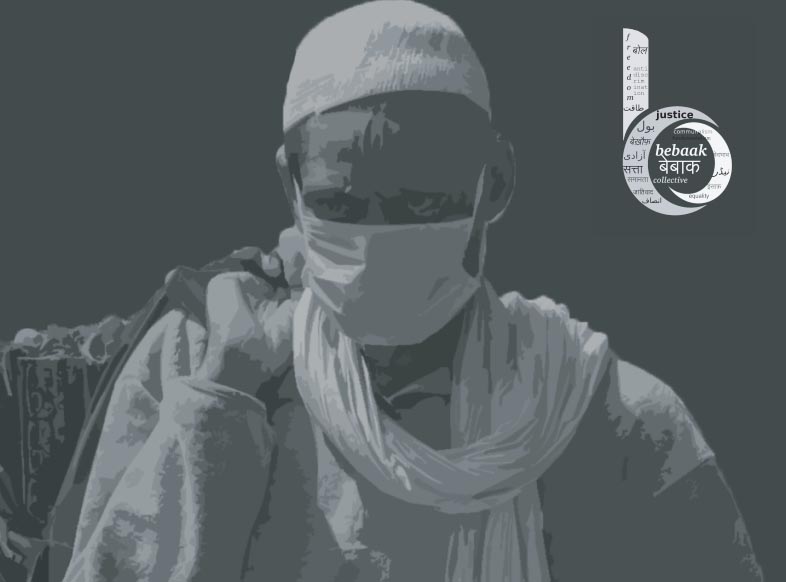
While the pandemic rages and continues to take lives, the measures to control it have starkly highlighted the various inequalities existing in the country, says the Communalisation of Covid-19 report published by Bebaak Collective, an umbrella body of various women’s groups.
According to authors Hasina Khan, Khawla Zainab and Umara Zainab, the report that covers seven states of northern, western and central India documents the synchronised working of the media, police and state authorities as the primary force which allowed for the discrimination, violence and exclusion faced by Muslims during the pandemic.
During a virtual conference on January 21, Khan said the Collective felt a need for such a report following the Tablighi Jamaat incident in March 2020. Muslims were quickly equated with the ‘virus’ and the ‘disease’ itself and feared, hated and contained.
“Pandemics are used in history to target socio-economically suffering sections of society. There have been historical incidents wherein vulnerable communities were targeted for pandemics such as Nazi Germany accusing Jews or the targeting of the queer community for the rise in AIDS cases,” she said.
The community suffered several hate crimes and discriminatory incidents that further eroded their rights as citizens. Interviews of various civil society organisations, student activists, human rights lawyers, other individuals and groups working on the frontlines showed the pattern of anti-Muslim violence used against the community members.
The report markedly talked about the impact of fake news and hate speech against Muslims on social media. Khan said the manner in which the media discussed the Tablighi Jamaat incident was concerning and begged a reason for the politicisation of a pandemic, especially considering the lack of responsibility taken up by the administration.
Moreover, real-world experiences of Muslims, who survived communal slurs and palpable hate-defined interactions, reflected this vitriol against Muslims in neighbourhoods, communities and workplaces.
In fact, Umara Zainab said that pre-existing notions against Muslims amplified the idea of Muslim spreading the virus.
“The language of spreading Covid-19 and its prevention fit the Muslim stereotype of enemy of nation. This hate speech is responsible for many incidents of violence against Muslims,” she said.
She talked about a relief worker in Malegaon, Samar, whose neighbour celebrated every new coronavirus case involving a Muslim and about Lucknow relief worker Zohra whose Hindu neighbour called passing Muslims as “corona.”
In another instance, she talked about a group of labourers who hesitated to identify as Muslims fearing they would not be allowed to board the special train for migrant workers. The report also stated that people both working as relief workers and receiving relief were discriminated against. Zainab talked about a group of seemingly aloof labourers who hesitated to accept relief from Muslims due to prevailing rumours.
Similarly, the report observed a dual impact of the February pogrom in Delhi and the March lockdown on the people of north-east Delhi on the rehabilitative process that had just begun. The Eidgah camp was closed due to the lockdown forcing displaced riot victims to fend for themselves or return to their charred and burnt homes or take refuge in the homes of willing neighbours.
“A result of being blamed for the pandemic was that Muslims internalised the fear of being mistreated and mistrusted by people and the administration. They did not trust anyone to look after them and were apprehensive of seeking help,” said Zainab.
Bhopal especially seemed like two nations, she said wherein the Muslim area was contained and patrolled after every 500 metres. Every house was separated, people were not allowed outside their house while pregnant women were asked to approach hospitals at different times as they might be carriers.
Co-author Khawla further stated that Muslims took on a double brunt of performance as the most secular initiatives of the pandemics were started by Muslim groups to dispel the idea that they spread the disease.
There were also several cases of violent incidents of social boycott largely in the informal sector where more than half of the Muslim population is employed. Residential colonies barred entry of Muslim vendors.
She spoke of an incident where Muslims girls in Baroda, Gujarat tried to get admission in local schools through NGOs. However, one school told the NGO workers that admitting 10 Muslim girls “is simply too much.” Another school said that Muslim girls will spread coronavirus in the school. Workers eventually admitted the girls to a farther and less desirable school.
In light of such incidents, the report recommended:
An effective overseer over media that fail to follow journalistic ethics;
Intervention of the Press Council of India and NBSA;
Introduction of a religion-based anti-discrimination law similar to the SC/ST Prevention of Atrocities Act;
Mental health support to Muslims who faced widespread stigma, hatred and discrimination;
Implementation of the Sachar committee recommendations especially the Equal Opportunity Commission and Diversity Index;
Supreme Court cognisance of this gross hate propaganda.
Related:
Communalisation of COVID-19: A Bebaak Collective report
A 2020 Report of 10 Worst Victims of Apathy: India’s Migrant Workers